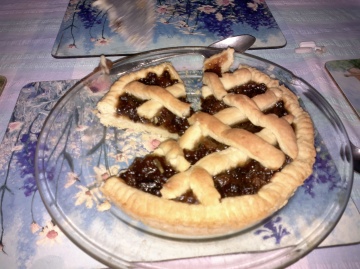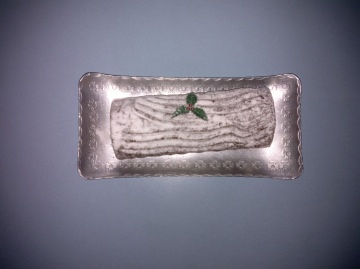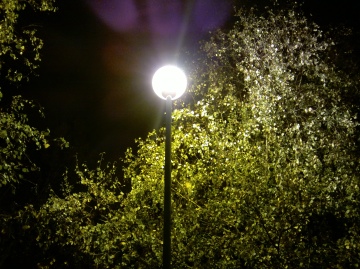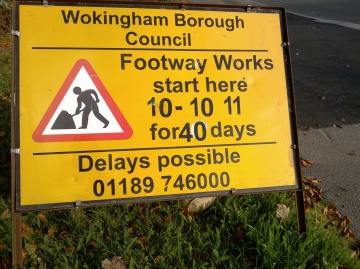Review: Nokia 701 - part 1: Hardware and Performance
The second of the (native) Symbian Belle smartphones to be reviewed here, the Nokia 701 takes a huge amount of cues from the year old C7, which is its direct ancestor. The changes (there are more than you might think, especially if you've scanned other sites' cursory 701 once-overs) are mostly all positive, though some will be a little sad to see AMOLED not in the picture. An (admittedly improved) EDoF camera remains a controversial choice, but camera-aside, the powerful internals in the 701 make it great value for money.
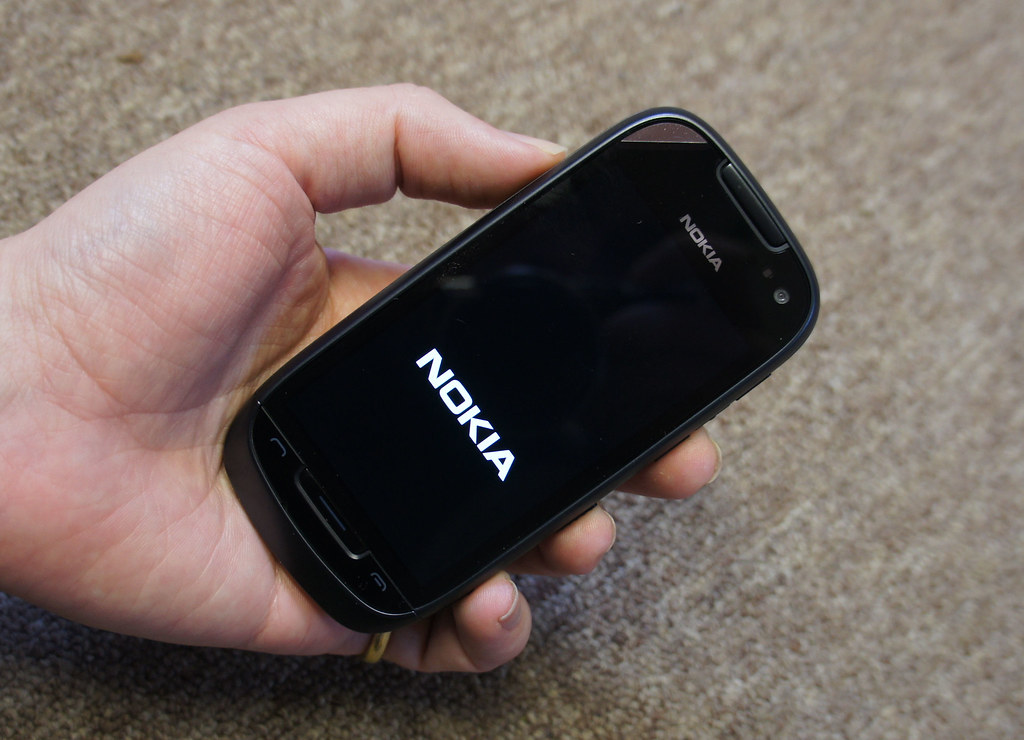
Where to start? Tech spotlights
Reviewing a smartphone which is so physically similar to an existing one (the C7) and which is so similar in software to a different device (the 700) is something of a challenge. One aspect I did want to highlight was the areas in which there has been technical progress, which is why I've done three tech pieces in the last week here on AAS, looking at:
- the increased capacity of the standard BL-5K battery, this seems to be part of a programme of upgrading standard Nokia cells, typically by up to 10%, a useful boost by anybody's standards.
- the significant improvement in photo quality from the EDoF camera, including the ability to resolve detail clearly for subjects as close as 35cm. (The improvement is due to the extra image processing power made available by the new graphic chipset in the 701, so it's not something that can be rolled out to older EDoF-equipped phones)
- the use of an IPS display with CBD rather than a plain AMOLED (as on the C7), resulting in slightly paler colours and less impressive 'blacks', but with the advantages of lower power drain when viewing emails, web pages, store pages or social updates, plus far better contrast when outdoors in sunlight.
All of which I'll be mentioning in passing below, but the links above will give more information.
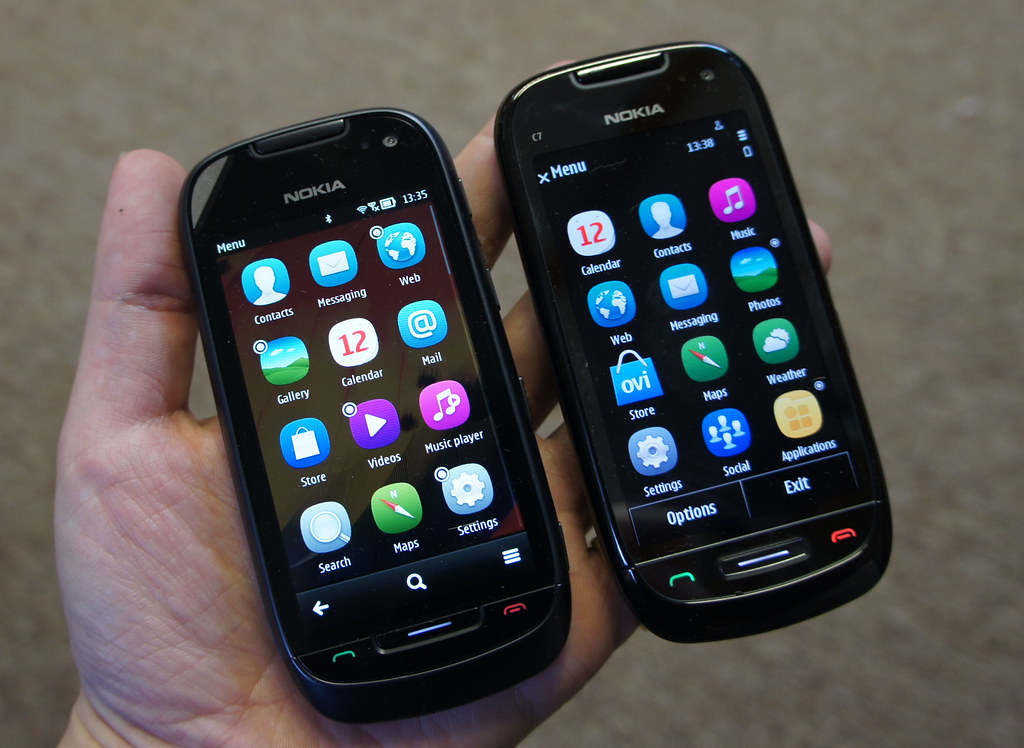
Nokia C7 to Nokia 701
Given that the Nokia 701 and the year old Nokia C7 are virtually ringers for each other and share a huge amount in terms of design, it's also probably worth tabulating the differences before launching into an assessment of the 701 on its own merit. For brevity in the short table below, any common functions or specifications are ignored. Here's what's different, then:
| 701/C7 differences | Nokia C7 (Oct 2010) | Nokia 701 (Oct 2011) |
| Weight | 130g | 131g (essentially an identical form factor) |
| Display | 3.5" AMOLED | 3.5" In Plane Switching (IPS) TFT, ClearBlack Display polariser arrangement |
| Processor, memory | 680MHz ARM-11, 256MB RAM, Broadcom BCM2727 graphics processor | 1GHz ARM-11, 512MB RAM, Broadcom BCM2763 graphics processor (much used by EDoF, see below) |
| Battery | BL-5K stated at 1200mAh | BL-5K stated at 1300mAh, a new variant with extra capacity |
| OS | Symbian^3, upgraded to Anna, Belle coming soon | Symbian Belle - several worthwhile UI changes, several which are definitely 'sideways' steps for an existing Anna user. |
| Cellular data capability | HSDPA, 10.2 Mbps; HSUPA, 2 Mbps | HSDPA, 14.4 Mbps; HSUPA, 5.76 Mbps. Faster is always better, of course, though note that the maximum speeds you'll see in the real world will almost always be determined by your local network signal and capacity. |
| Cosmetics | Extra, mirror-finish oleophobic coating on screen | Relocated home/menu key, matt finish on the plastic device bezel, for extra grip |
| Camera | 8 megapixel EDoF, 'full focus' resolved down to 50cm, fairly heavy use of edge enhancement, dual flash, flush shutter key | Raised shutter key for easier location without looking, same 8mp unit, with new (Belle) camera interface, increased graphics power, now resolving 'full focus' down to 35cm and with far more natural look to photos |
| Extras | Partial Near Field Communications with Symbian Anna, full functions to be added with Belle? | Full Near Field Communications functionality from day one |
A common question is going to be: "I have a Nokia C7 and like the form factor, but should I sell it and upgrade to a 701?"
Unless the improved camera capability is critical (and it's unlikely to be, otherwise you'd have an N8!), I'd suggest "No" since the C7's about to get Symbian Belle anyway in an update. This will bring better RAM management and the new UI, plus fuller NFC functions, making better use of the C7's existing hardware. IN addition, I'm sure it'll be possible to buy the 1300mAh version of the BL-5K at some point, as a standalone accessory. And you'd get to carry on enjoying the rich AMOLED colours*.
* One further side note is that many C7 units do seem to have received the 'faulty' purple-tinged AMOLED screen - a saga which is still ongoing. In such a case I'd say that this factor tips the balance and that giving up on AMOLED and making the switch to the IPS-screened 701 is probably the way to go.
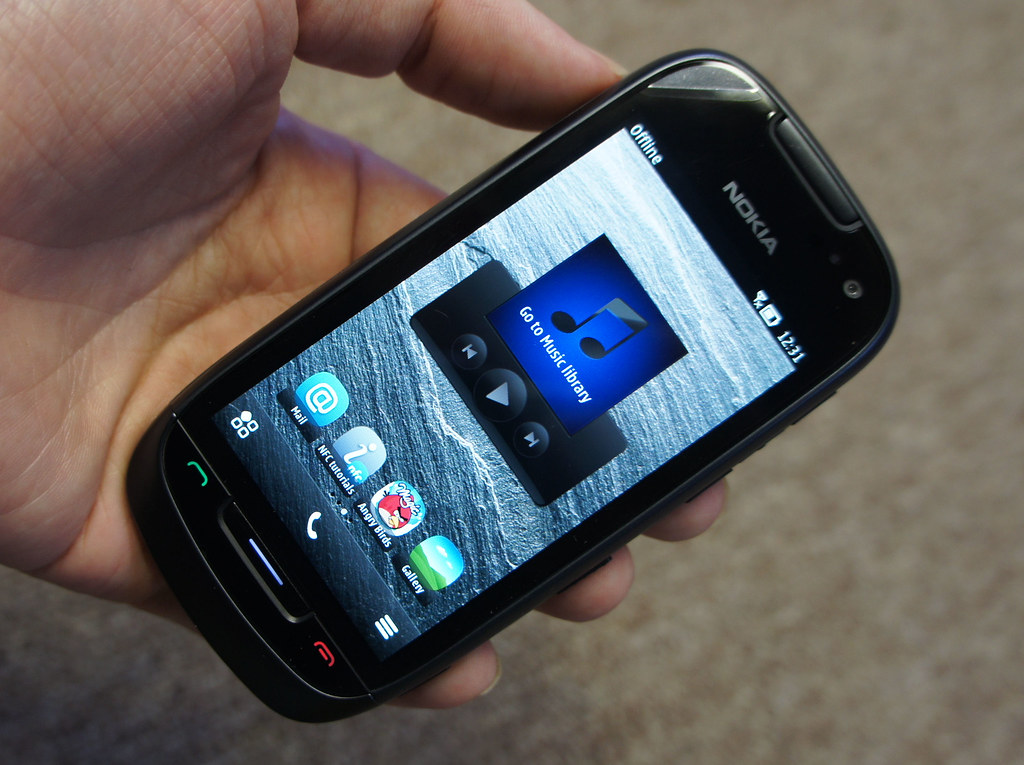
The Nokia 701
If there's one thing that Nokia got absolutely right in the design of the C7, it was the form factor. Yes, the geeky top end of the market is moving towards huge-screened superphones (4.7" and rising?), but for a mainstream, informed phone user, the C7's size, curves, weight distribution fitted the hand perfectly. The 701 recognises this and continues the form factor, to all intents and purposes the same hardware chassis.
The balance between being too angular (e.g. the Nokia N8 or the smaller 700) and being too curved (the Palm Pre springs to mind) can be tough to get right, but the C7/701 nails it. I've been able to give the 701 to non-geeks and it has received universal praise for its feel in the hand. Obviously this is somewhat subjective, but the 701 is a good candidate for being "the smartphone for the rest of us". Where "us" is, again, those who aren't hardened top-end smartphone geeks and early adopters.
Front and centre is the excellent IPS/CBD display that I've already analysed, making sure that what's on screen can be seen in all light conditions. It's Gorilla glass too, so will stay looking great for the lifetime of the phone.
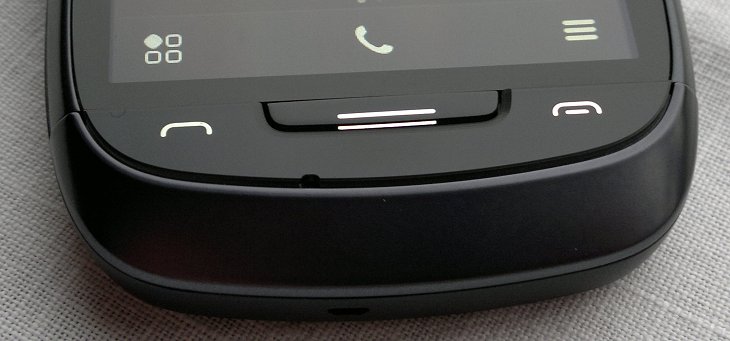
Below the display are physical call/hangup buttons, very reassuring - most of us have had at least one occasion when we've either been called and unable to pick up because the touchscreen icon wasn't responding, or on a call and having to mess around trying to find the 'Phone' application again in order to hang up the call. Also, bearing in mind the target market, especially those moving up from feature phones, they'll be expecting dedicated telephony keys. If I'm being a little picky, the plastic used for this key-pair panel is a little cheap and creaks slightly. In addition, the menu/home key is also cheaply made and wobbles a little.
But that'll be my last complaint about the Nokia 701's hardware, since the build quality and materials used are otherwise exemplary. The plastic used for the main chassis is solid as a rock and very reassuring, the steel battery cover fits snugly and securely, and the buttons around the outside are plastic but fit very well.
On the 701's left side is a 2mm charging port - a slightly odd location but you can also charge via microUSB if you prefer, using the data port on the phone's top (under a tethered flap). Great to have the dual charging options, as always - add in the easily replaceable BL-5K battery and you have the basis for a phone which should never let you down in terms of charging flexibility.
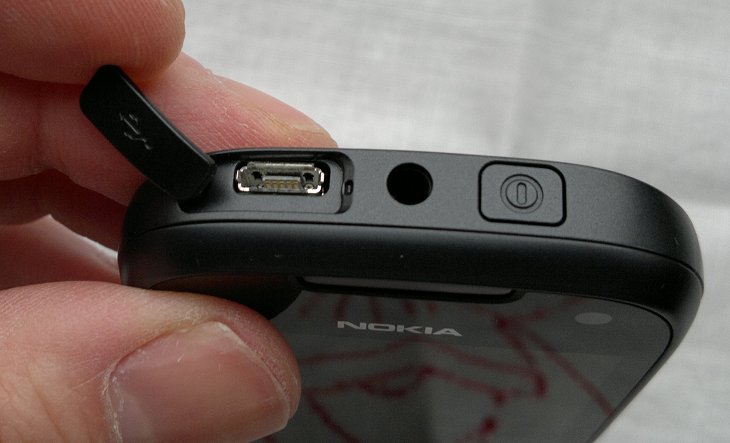
The 701's sides are rounded out (literally, given the styling) with a 3.5mm/AV-out port and power button on top, volume/zoom and voice command buttons top right, the great keylock toggle middle right and a nicely designed camera shutter key, bottom right. This latter is notable because the shutter key on the old C7 was flush with the phone's case and almost impossible to find without looking - the 701's shutter key can be found by your right index finger 'blind', making for faster photo taking.
On the back of the 701, the way the stainless steel battery cover merges seamlessly with the curved plastic chassis is a real tribute to Nokia's design and manufacturing prowess - it looks great and feels great. As on the C7, the camera island sits around a millimetre proud of the back surface of the phone and incorporates the camera 'glass' (thankfully indented a millimetre rather than being flush and vulnerable), twin LEDs and a mono speaker (plus matching 'fake' speaker grille below).
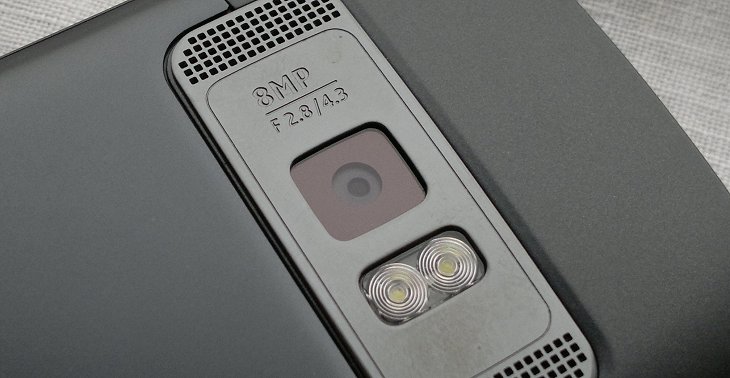
Camera island
All of these camera island items are worthy of extra comment. The camera on the 701 is Extended Depth of Field (EDoF) and, as I reported in detail, is significantly improved in terms of its results (compared to previous EDoF units on other phones) because of the greater image processing power available to help the EDoF decoding. After reading my earlier analysis, the best way to illustrate the quality produced is to put up a gallery of sample photos taken on the review Nokia 701. In each case, click on the screen width photo to bring up (or download) the original 8 megapixel EDoF image at full resolution:
Typical people shots, the first (in very weak winter sun) from about 40cm, the second (in overcast conditions) from about 70cm - the EDoF optics are fairly wide angle...
Good light shots, good detail and colour - and not too many EDoF artefacts?
Shooting food is fairly popular, it seems, and one common use case cited as unsuitable for EDoF - here are a couple of examples shot (with LED flash) on the Nokia 701 - quite good enough?
EDoF photos have traditionally been poor in low light - the new image processing seems to have improved things quite a lot. See these two examples, both snapped with everything on 'automatic'...
A nice EDoF 'everything in focus' graveyard shot (overcast conditions) and an equally depressing(!) roadworks sign (in weak sunlight)...
In summary, I was impressed. Where EDoF was marginal for some people before, in terms of useful photos, I think the vast majority of users will now be pleased with the 701's output, even in low light situations. Yes, there's still a 'macro' limitation, but even that's been mitigated somewhat. Yes, I personally would still rather have an auto-focus camera (especially one as good as the N8's), for extreme close-ups and for 'arty' depth of field shots, but then that's me - I can see a huge number of less photo-proficient 701 owners snapping away and being delighted with how well their photos turn out.
As usual with EDoF video, the way everything's in focus all the time helps enormously when you're moving around capturing a family scene, without having to worry about focussing and without having annoying periods of several seconds, when changing subject, where a focussing routine would have to 'lock on' again. The 701 also seems to have the digital microphone from the other Symbian^3 handsets, producing a superior soundtrack - all in all, the 701 is a stunning video capture phone. The highest resolution is 720p, but this will be enough for everyone other than ultra-geeks wanting cinema playback on massive TVs.
Here's a test clip to put EDoF to a tough test: mixed subject distance in very poor light (just before dusk, UK winter):
Up the resolution in the YouTube window and make full-screen for best effect. Note that this also has YouTube encoding added. Click here for the original MP4 file
The dual LED flash works well enough within the usual limitations of LED flash, i.e. it's never enough to really freeze movement at parties and the like (Xenon needed for that), but it's fine for posed night shots, as shown above. Despite marketing claims (and what other 'reviews' of phones say), the dual LED is competlely useless as a night time video light. While bright enough to illuminate something, it's not bright enough to produce good enough video, while being too bright for any human beings to look at you and be filmed. It's a lose-lose situation.
Thankfully, the LED also another great use in the built-in torch function, available in all the Symbian^3/Anna/Belle handsets (other than the Xenon-equipped N8). In keylocked state, pull down and hold the keylock button for five seconds and the dual LEDs light up as a surprisingly bright torch - it's very useable on a dark night and one less gadget to remember to bring with you.
Finally, the mono loudspeaker is identical to the one in the C7 but has noticeably better tone (i.e. less tinny, better frequency response). This seems to be down to software and chipset improvements in the way the speaker is driven - in use, I found it similar to the N8's speaker, which is something of a compliment.
Internals
The battery cover detaches with the same secure spring catch as the C7, revealing a 1mm foam pad glued to its inside. This is because there's otherwise an air gap between the BL-5K's surface and the cover and a risk of rattling or (worse) the battery working loose. Interestingly, as previously reported, the BL-5K has an upgraded capacity, at 1300mAh, which is nice - but it's galling to see the extra millimetre (at least) of depth totally wasted here. I'd have though that a 'BL-5Jx' or similar, with increased vertical bulk, could have seen an increase to 1500mAh, all without altering the 701 (or C7's) casing at all. A to-do item for Nokia's battery teams?
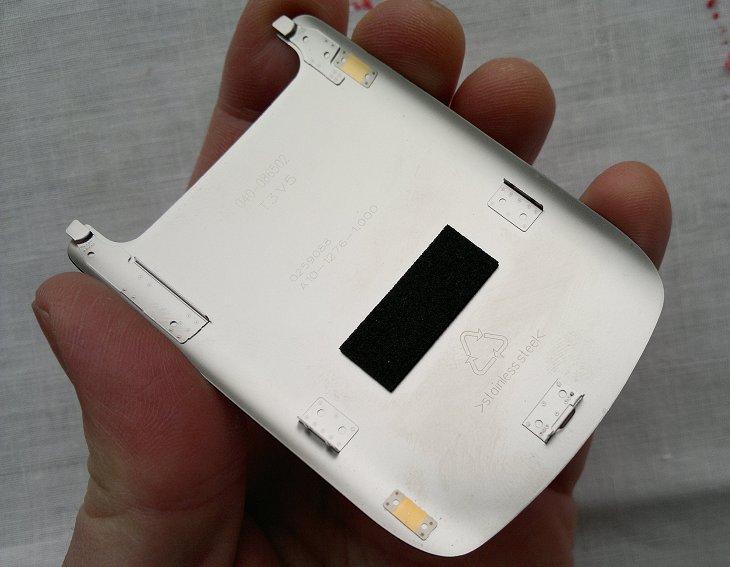
Electrodes at each corner of the battery cover show that the metal is being used as an aerial, in this case for the FM Transmitter ('Play by radio') function. The cover fits so well that I didn't have an problems with intermittent connections when playing music in the car.
The SIM slot is easily accessible, but you still can't hot-swap SIM cards - try and insert a SIM while the phone's powered up and it will complain that it needs to 'restart'. Which is fair enough, but it would be nice to be able to hot swap SIMs at some point on our Symbian smartphones. Maybe this feature will appear one day.
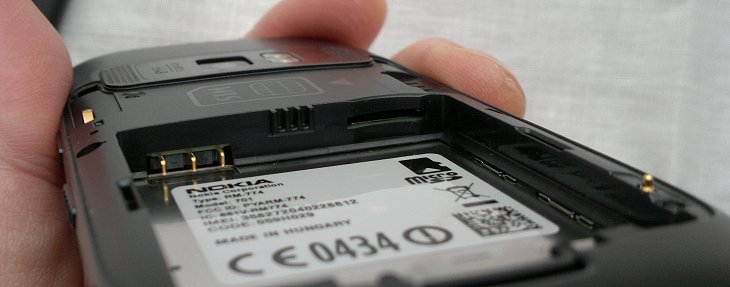
Somewhat controversially, the microSD slot is hidden within the battery bay, so is definitely not hot-swappable. A shame, since Symbian does support on-the-fly card changes (subject to closing apps where needed), but in truth card changes are comparatively rare these days and I don't think this will inconvenience too many 701 users. The device comes with 8GB of mass memory, plus a generous 600MB or so of internal (system) disk, in addition to the card slot - many users may not need to even buy a card for a while. I tested the 701 with a 16GB microSD card and it worked very well, though 32GB should also be possible.
As mentioned above, the chipset used in this generation of Symbian Belle devices is different to that for Symbian^3/Anna, with a faster 1GHz processor giving the 701 an extra turn of speed in general operation. Although it's not immediately noticeable when you switch to the 701, it's far more evident when you perhaps switch back to an older device and it immediately feels a lot slower.
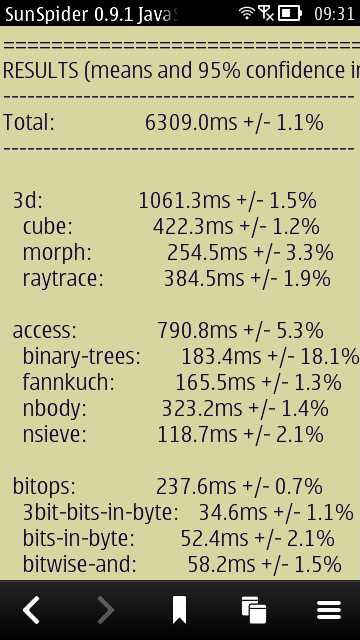
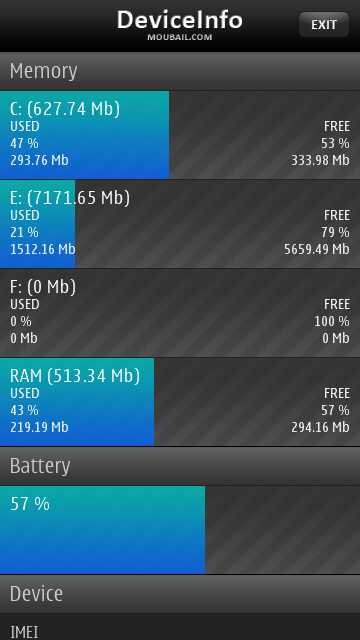
Battery life is good in the Nokia 701 - better than expected, given the faster processor. I've been getting through two average days on a single battery charge - intensive use would see this drop to a single day, but this is a minimum.
This longevity is partly due to the increased battery capacity, partly due to the use of a IPS display rather than AMOLED, partly due to the new chipset and partly due to new optimisations in Symbian for this Belle release. Four factors then, all contributing to a smartphone with a genuinely impressive battery life.
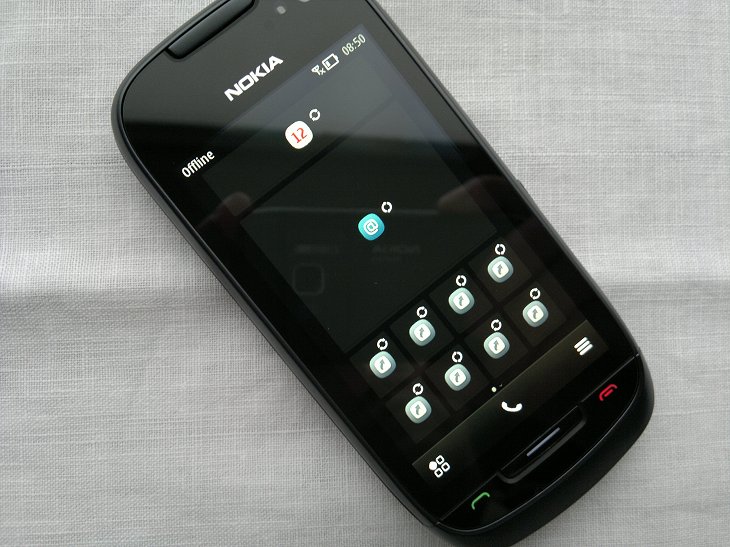
Starting up!
Belle on the 701 and verdict
I'll be looking, in part two of this full review, at Symbian Belle on the 701, with its relatively large and clear screen and consummate feel in the hand. Is this a Symbian flagship at a mid-tier price? Is this the best all round Symbian-powered phone ever? Maybe. And maybe not. Watch this space...
Steve Litchfield, All About Symbian, 21st November 2011
Reviewed by Steve Litchfield at





